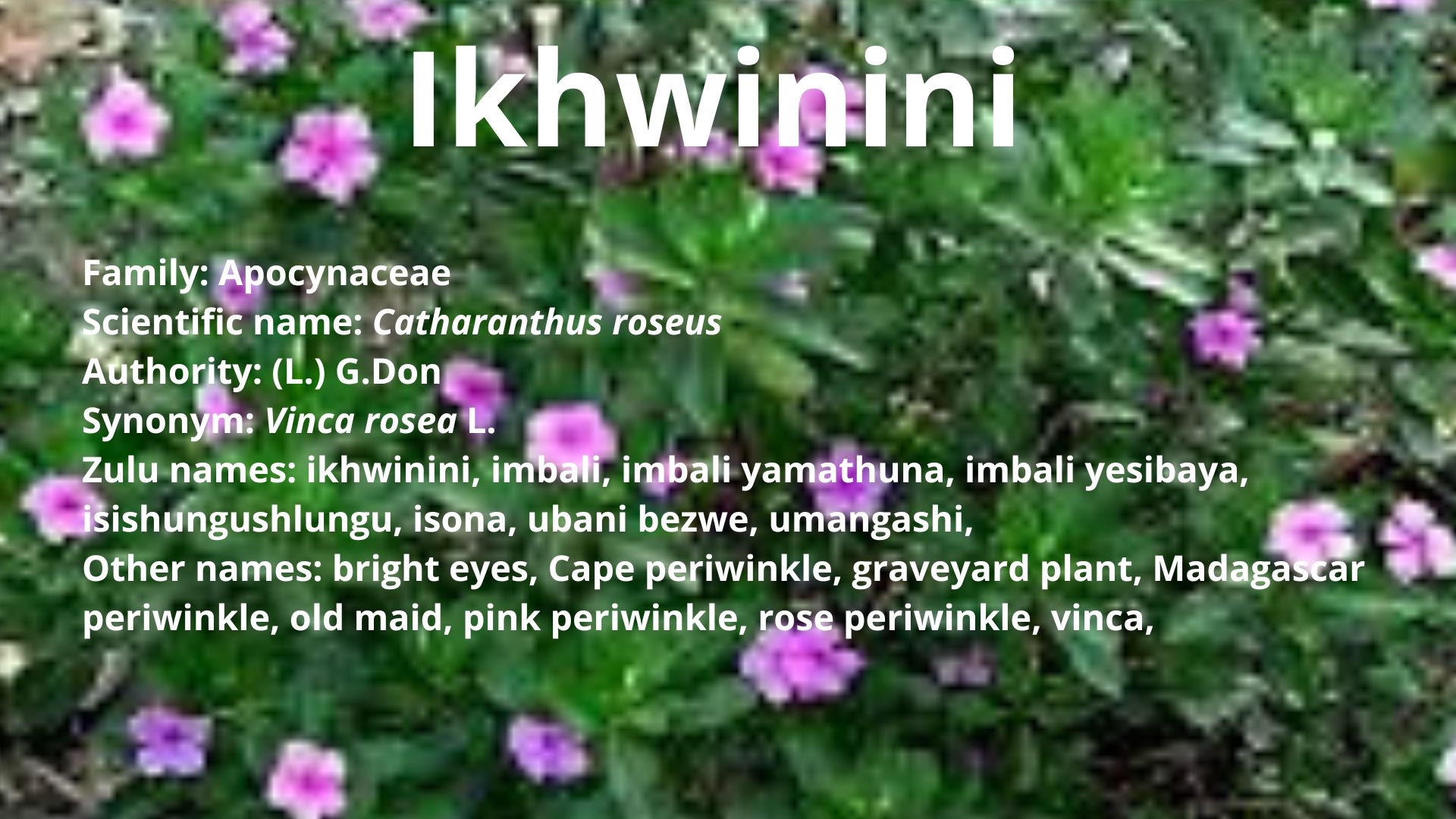Family: Apocynaceae
Scientific name: Catharanthus roseus
Authority: (L.) G.Don
Synonym: Vinca rosea L.
Zulu names: ikhwinini, imbali, imbali yamathuna, imbali yesibaya, isishungushlungu, isona, ubani bezwe, umangashi,
Other names: bright eyes, Cape periwinkle, graveyard plant, Madagascar periwinkle, old maid, pink periwinkle, rose periwinkle, vinca,
Description: Catharanthus roseus is an evergreen annual perennial woody herb. It has glossy ovate leaves, large pink flowers with a red centre and reddish flowers with a white centre and white flowers and a yellow centre, and a pair of follicles as fruits.
Uses:
- The leaves are cooked with beetroot together with a can of beer and the mixture is administered as a drink.
- The leaves are used to lower the high blood pressure, treat hypertension.
- The flowers are used to make tea to cleanse the blood.
- The milky sap is used for insect bites and warts.
- The roots and leaves are used as an ingredient in the making of a powder that is known as isihlungu, that is inhaled or licked to treat headache.
- The roots are used to make a decoction that is gargled with to relieve toothache.
- The roots and leaves are used to deworm humans, especially when the worms attempt to come out orally.
- The roots and leaves are used to treat sexually transmitted infection, especially the one known as drop.
- The plant is used to treat diabetes. The leaves are used to treat diabetes.
- The plant is used to treat skin problems such as dermatitis, eczema, acne,, and wounds.
- The plant is used to treat stomach cramps. The roots are used to treat diarrhoea.
- The plant is used to treat gonorrhoea.
- The plant is used to treat rheumatism.
- The plant is cultivated as a bedding garden plant.
References and further reading:
- Arnold, T.H., Prentice, C.A., Hawker, L.C., Snyman, E.E., Tomalin, M., Crouch, N.R. and Pottas-Bircher, C., 2002. Medicinal and magical plants of southern Africa: an annotated checklist. Strelitzia 13. National Botanical Institute, Pretoria.
- Aslam, J., Khan, S.H., Siddiqui, Z.H., Fatima, Z., Maqsood, M., Bhat, M.A., Nasim, S.A., Ilah, A., Ahmad, I.Z., Khan, S.A. and Mujib, A., 2010. Catharanthus roseus (L.) G. Don. An important drug: it’s applications and production. Pharmacie Globale (IJCP), 4(12), pp.1-16.
- Bruneton, J., 1995. Pharmacognosy, phytochemistry, medicinal plants. Intercept, Hampshire.
- De Wet, H., Nkwanyana, M.N. and Van Vuuren, S.F., 2010. Medicinal plants used for the treatment of diarrhoea in northern Maputaland, KwaZulu-Natal Province, South Africa. Journal of Ethnopharmacology 130, pp.284–289.
- De Wet, H., Ramulondi, M. and Ngcobo, Z.N., 2016. The use of indigenous medicine for the treatment of hypertension by a rural community in northern Maputaland, South Africa. South African Journal of Botany 103, pp.78–88.
- Marles, R.J. and Farnsworth, N.R., 1995. Antidiabetic plants and their active constituents. Phytomedicine 2, pp.137–189.
- Nayak, B.S. and Pinto Pereira, L.M., 2006. Catharanthus roseus flower extract has wound-healing activity in Sprague Dawley rats. BMC Complementary and Alternative medicine, 6(1), pp.1-6.
- Nisar, A., Mamat, A.S., Hatim, M.I., Aslam, M.S. and Syarhabil, M., 2016. An updated review on Catharanthus roseus: phytochemical and pharmacological analysis. Indian Research Journal of Pharmacy and Science, 3(2), pp.631-653.
- Paarakh, M.P., Swathi, S., Taj, T., Tejashwini, V. and Tejashwini, B., 2019. Catharanthus Roseus Linn-a review. Acta Scientific Pharmaceutical Sciences, 3(10), pp.19-24.
- Pooley, E., 2006. Forest plants in the forest and in the garden: Popular guides to the biomes of South Africa. The Flora Publication Trust, South Africa.
- Van Wyk, B.E. and Gericke, N., 2000. People’s plants. A guide to useful plants of southern Africa. Briza Publications, Pretoria.
- Van Vuuren, S.F. and Naidoo, D., 2010. An antimicrobial investigation of plants used traditionally in southern Africa to treat sexually transmitted infections. Journal of Ethnopharmacology, 130(3), pp.552-558.
- Watt, J.M. and Breyer-Brandwijk, M.G., 1962. Medicinal and poisonous plants of southern and eastern Africa, second edition. Livingstone, London.

